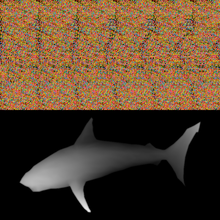The magic eye
The Magic Eye (in the original Magic Eye ) is a series of books with computer-generated stereograms that has been published since the 1990s. The Magic Eye images were developed by Tom Baccei .
technology
The Magic Eye images are autostereograms, more precisely single image stereograms (SIS). An image is placed on an initial image that is similar to the original image, but is offset or discolored in places by a few pixels. The human brain “develops” the hidden three-dimensional image from the difference between the two images. In order to see this, the viewer must concentrate with both eyes on a fictitious point behind the magic eye image. The brain then processes the information from fixing the point behind the image and actually seeing the image into a 3-D motif.
Not all people are able to see the 3-D objects in the Magic Eye images. In addition to incorrectly applied viewing techniques, the main cause is inadequate or faulty cooperation between the eyes, for example in the case of visual disturbances such as strabismus , pronounced eye dominance or astigmatism .
history
At the beginning of the 1990s, the American Tom Baccei experimented with random dot space images ( English random dot stereograms ) and developed a variant in which the hitherto random point patterns were replaced by more or less abstract shapes and patterns, and later partly also by real images have been replaced. He initially called his pictures "Stare-EO" and published them in various magazines. The images met with great interest in the population, so Baccei decided to market the stereograms in book form. He founded NE Thing (pronounced anything ) and published the book Magic Eye: A New Way of Looking at the World in 1993 . The book quickly developed into a bestseller, with volumes 2 and 3 appearing within a few months. Baccei then renamed his company Magic Eye Inc. In German-speaking countries, the series was published in 1994 under the title Das Magische Auge by arsEdition in Munich.
The book series developed into an international bestseller. In 1994 all three volumes were on the New York Times bestseller list in the USA, all three volumes were also on the sales charts in Great Britain, and in Germany the books were all placed on the list of the best-selling non-fiction books in 1994 . In addition to the standard books, various other themed books have been published, for example on Harry Potter or at Christmas time with correspondingly festive motifs. The Magic Eye books have been translated into over 25 languages, and worldwide sales are in the tens of millions.
For the 25th anniversary of the first book, Magic Eye Inc. published an anthology in 2018, which was also published in 2019 as The Magical Eye Anniversary Volume in German-speaking countries.
Wizzy Nodwig
As the mascot for the Magic Eye books, Baccei Wizzy developed Nodwig, a teenage magician with a large hat. The name of the figure alludes to the term WYSIWYG . This comes from computer word processing and means in full "What You See Is What You Get" ( German What you see is what you get ). The similarly pronounced name "Wizzy Nodwig" is intended to refer to the hidden 3-D images, as these are initially invisible to the viewer ("What You See Is Not What You Get", ( German What you see is not what you get )). The figure first appeared in Volume 2 of the English-language book series.
Web links
- magiceye.com - Official website
Individual evidence
- ↑ Anke Waschneck: Magic Eye books: With these tricks artists deceive our eyes. Focus, November 20, 2016, accessed December 4, 2019 .
- ↑ Katharina Meyer: That's why you can't see these 3D images. desired.de, June 29, 2017, accessed December 4, 2019 .
- ↑ “It works! It works! ”The psychedelic 3-D pictures by the American Tom Baccei. Der Spiegel, March 14, 1994, accessed December 4, 2019 .
- ^ A b c John Grossman: In the Eye of the Beholder. Inc., October 1, 1994, accessed December 4, 2019 .
- ↑ a b About. Magic Eye Inc., accessed December 4, 2019 .
- ↑ Karina Liebenstein: bestseller lists 1962–2001. A statistical analysis . Book Studies / University of Erlangen-Nürnberg, Erlangen 2005, ISBN 3-9809664-2-9 , p. 65 f .
- ↑ It's going to be magical again! The "Magic Eye" celebrates its 25th anniversary. lifePR, January 9, 2019, accessed December 4, 2019 .
